In the Religious historical observatory Fabio Mora, one of the best specialists in contemporary religions, presents every year the most important religious-historical events of the previous year.
F. Mora, Religious historical observatory 2015, Charleston 2016, pp. 276, ISBN 978-1535413657 (buy)
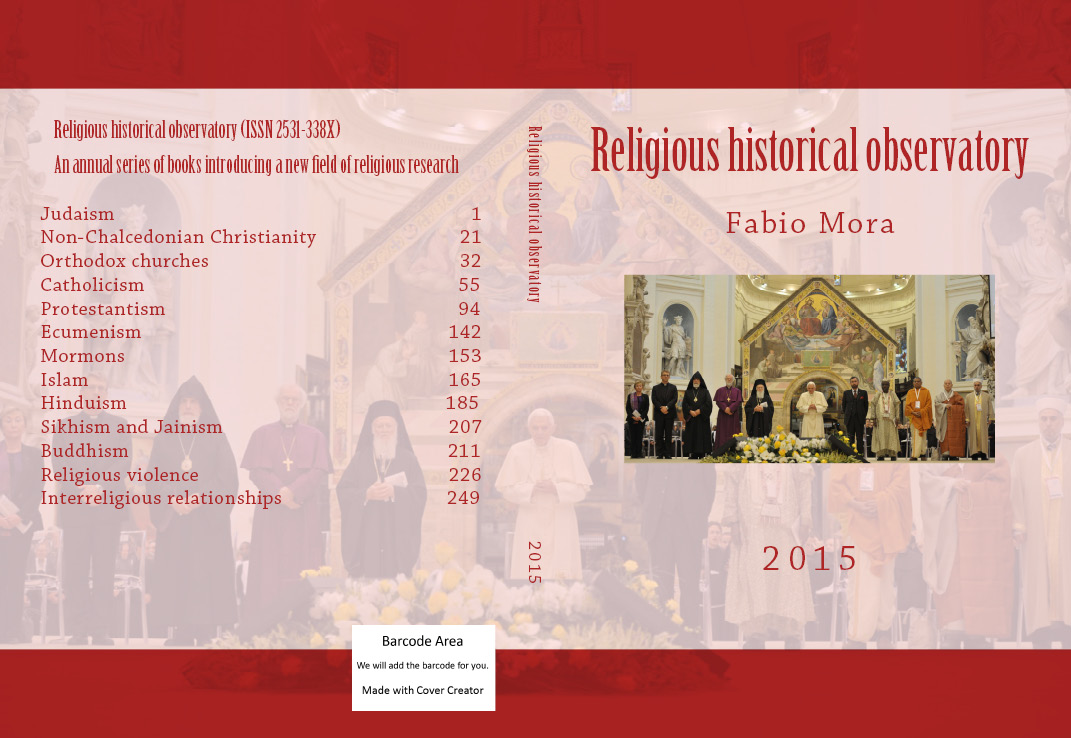
F. Mora, Religious historical observatory 2014, Charleston 2015, pp. 202, ISBN 978-1516867172 (buy)
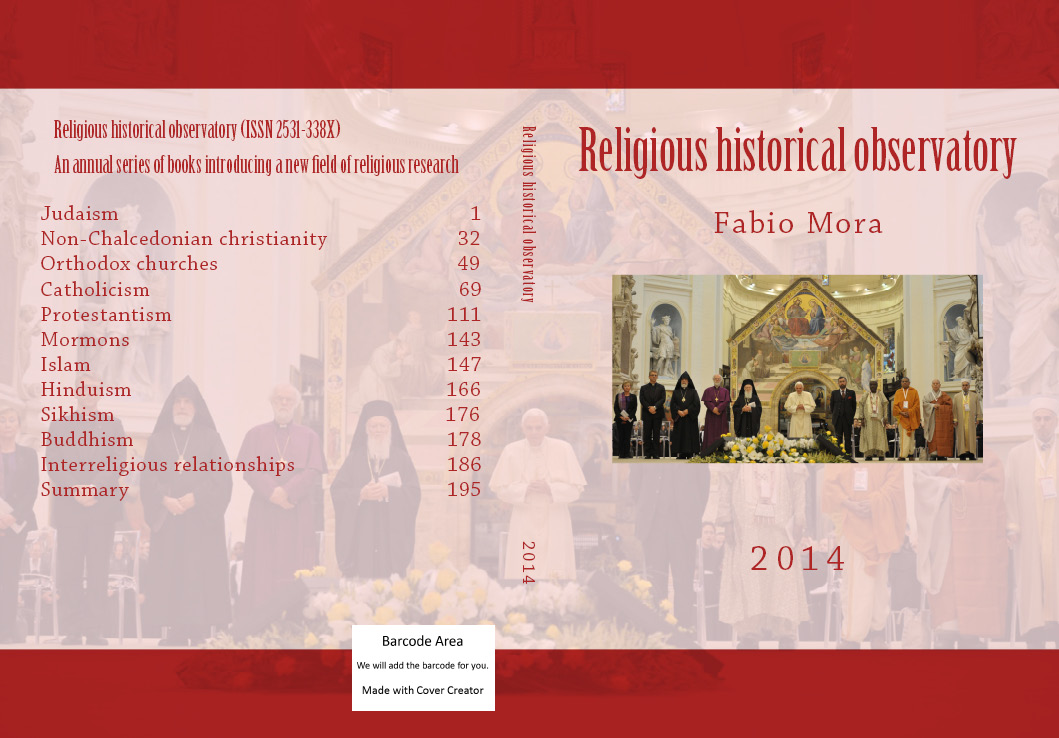
F. Mora, Religious historical observatory 2013, Charleston 2014, pp. 206, ISBN 978-1502856791 (buy)
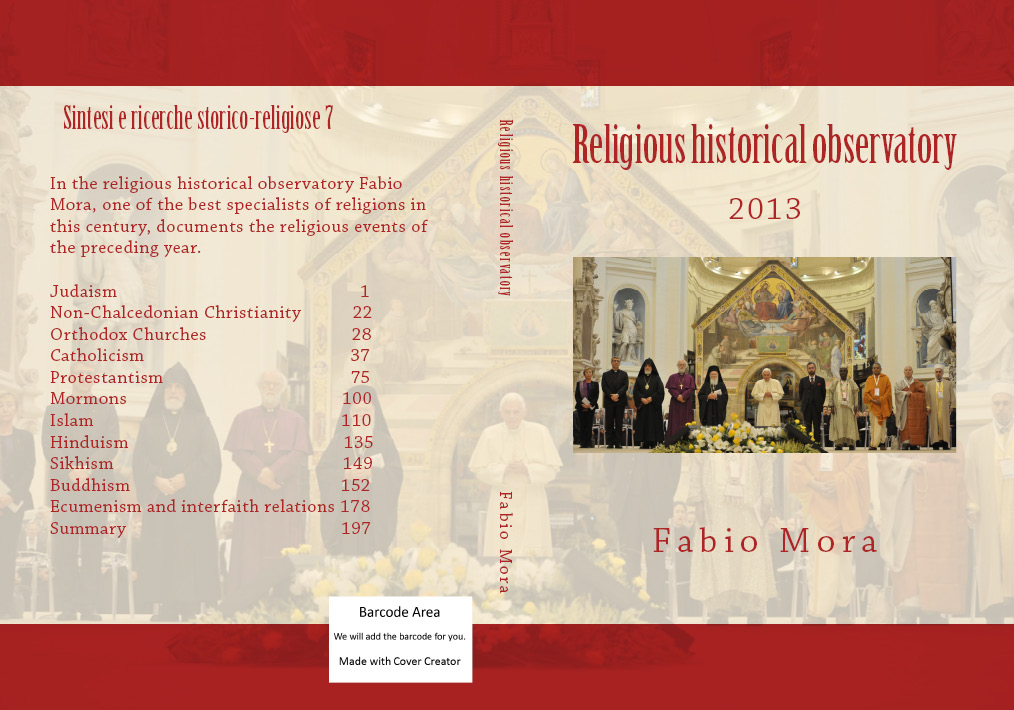
The Observatory 2013 reports:
- for Judaism on the first three female Orthodox clergy and Orthodox documents, new conservative standards, life of American Reform Judaism with its once in a life mixing of Hannukah and Thanksgiving, but also its decisive role in solving the crisis of the Women of the wall (who may now pray with male ritual garments at the Wall in Jerusalem), on the election of two new chief rabbis of Israel, on increasing problems with haredi in Israel, where they are no more represented in government and targeted by a new secular force, on worldwide anti-Semitism;
- for non Chalcedonian Christianity on two Coptic canonizations, on life of the Coptic church and the many attacks it endures, on tensions in the Armenian church;
- for Orthodox churches on the activity of the Ecumenical Patriarch and of the Patriarch of Moscow, on the new Bulgarian Patriarch, the process leading to a American Orthodox church and the kidnapping of two Antiochean bishops;
- for Catholicism on Benedict’s resignation, the conclave electing his successor, a short characterization of Francis I with a more detailed analysis of his Evangelii gaudium, with a new clear opposition to some Western values as the social enemy, on new saints and blessed, on various activity of the Roman curia and appointments in the local churches, on ordination of women and child sex abuses;
- for Protestantism on various activity of German Lutherans, on decisions made by the American Lutherans and their choice of their first female presiding bishop, on the unification of French Protestantism, on an Anglican document on sionism, on the merging of three English dioceses into a larger one, on a Mennonite/Amish pilgrimage to Israel to apologize for their insensitiveness to Holocaust, on scandals in the Anabaptist family, on Baptist resolutions, on Baptist and Methodist different attitude to gay scouts, on Methodists questioning online communion, on Adventists debating ordination of women, on Unitarian-Universalists’ penchant for polyamory;
- for Mormons mainly on the failed attempt to ordain women and the internet campaign claiming it;
- for Islam mainly on women’s condition, sexual ethics, Islam in the West;
- for Hinduism and Sikhism on a various chronicle of the year, with some attention to Hindu hate speech;
- for Buddhism on Tibetan Buddhism, with a greater wave of self-immolations, much activity of Dalai and Karmapa Lama, on Zen Buddhism, with a sex-scandal in America, that might rather depend from American misunderstanding of Buddhist ethics, on the death of the Thailand Theravada patriarch, on further steps toward a new Buddhist body, on tensions between Buddhists and Muslims in Myanmar;
- for interfaith relations mainly on a lot of interreligious (mainly Islamic) violence and much intrareligious, almost only Islamic violence, much religious discrimination;
- for ecumenism on some interdenominational dialogue of the Catholic church, but mainly on the assembly of World Council of Churches.
F. Mora, Osservatorio-storico religioso 2012, Charleston 2013, pp. 206, ISBN 978-149376829-5 (buy)
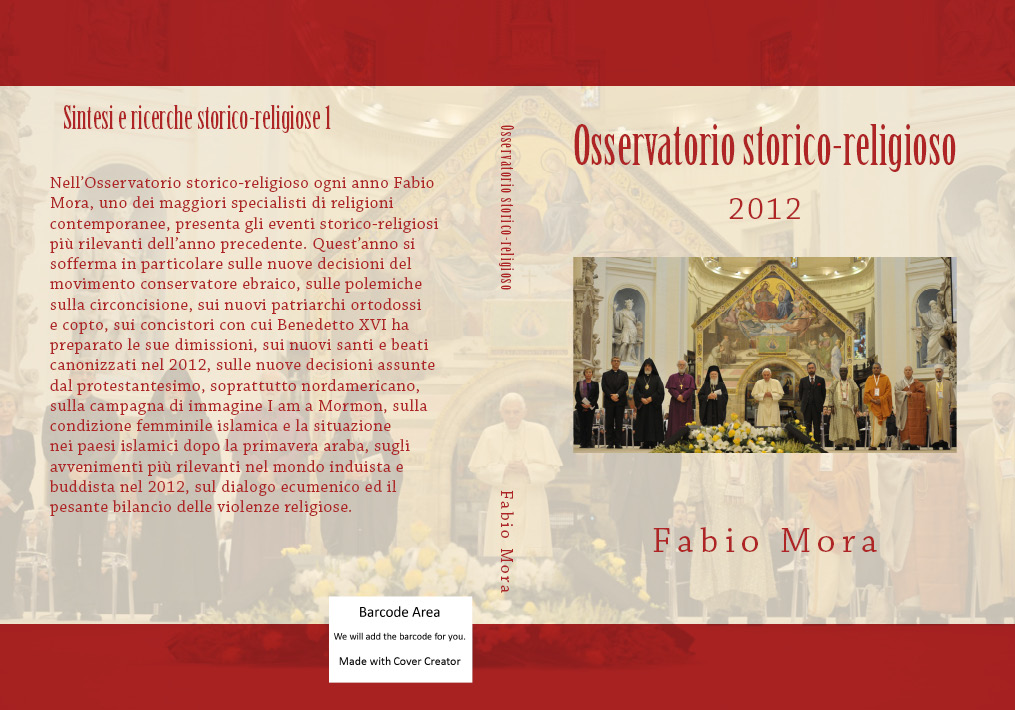
Osservatorio 2012 focuses in particular:
• for Judaism on new responsa of the conservative movement, on international controversy about circumcision and the ongoing conflict in Israel between ultra-Orthodox Haredi and secular members of society;
• for non-Chalcedonian Christianity on the problems of the Copts, targeted by Islamist violence, on Patriarch Shenouda III's death and the new Patriarch of Ethiopia;
• for Orthodoxy on the appointment of new patriarchs, the activity of the Russian Holy Synod, the first steps of a new Orthodox church in North America, but also on the controversy over the excessive hardness of the repression (also ecclesiastical) of the Pussy riot's protest;
• for Catholicism on the consistories in which Benedict XVI has prepared his resignation, on new saints and blessed canonized in 2012, on the alleged Vatileaks scandal (actually a hype);
• for Protestantism on the activities of the German Lutheran church, with particular attention to their revision of the lectionary, on the decisions made by the North American Presbyterians, on substitution of the Anglican Archbishop of Canterbury after the failure of his worldwide Anglicannew covenant, on the motions approved in their conventions by Methodists and Baptists, on new initiatives of the Seventh-day Adventists;
• for Mormons on the image campaign I am Mormon, and the relationship between Mormons and biblical scriptures in a devotional piece that provides a daily spiritual reading;
• for Islam on the situation after the Arab Spring and the status of women in relation to many issues (the protest by Saudi women banned from driving cars, new cases of honor killings, the issue of the veil and the very diverse image of Islamic female athletes at the Olympics);
• for Hinduism on different issues related to temples, pilgrimage, caste discrimination and significant events of 2012;
• for Tibetan Buddhism on deepening of political confrontation with the Chinese government in a particularly intense wave of self-immolations (almost three times those experienced in previous years) and on the Dalai Lama's and the Karmapa Lama's activities, for other forms Buddhism, especially on the death of Bangladesh's most famous monk , considered an arahant, destined to no more reincarnate.
It follows an evaluation of heavy inter-religious and intra-religious violence as well as of inter-religious censorship and other attacks on religious freedom; the point on inter-religious, and more specifically ecumenical, dialogue concludes the volume.
F. Mora, Osservatorio-storico religioso 2011, Charleston 2013, pp. 184, ISBN 9788890622250 (buy)
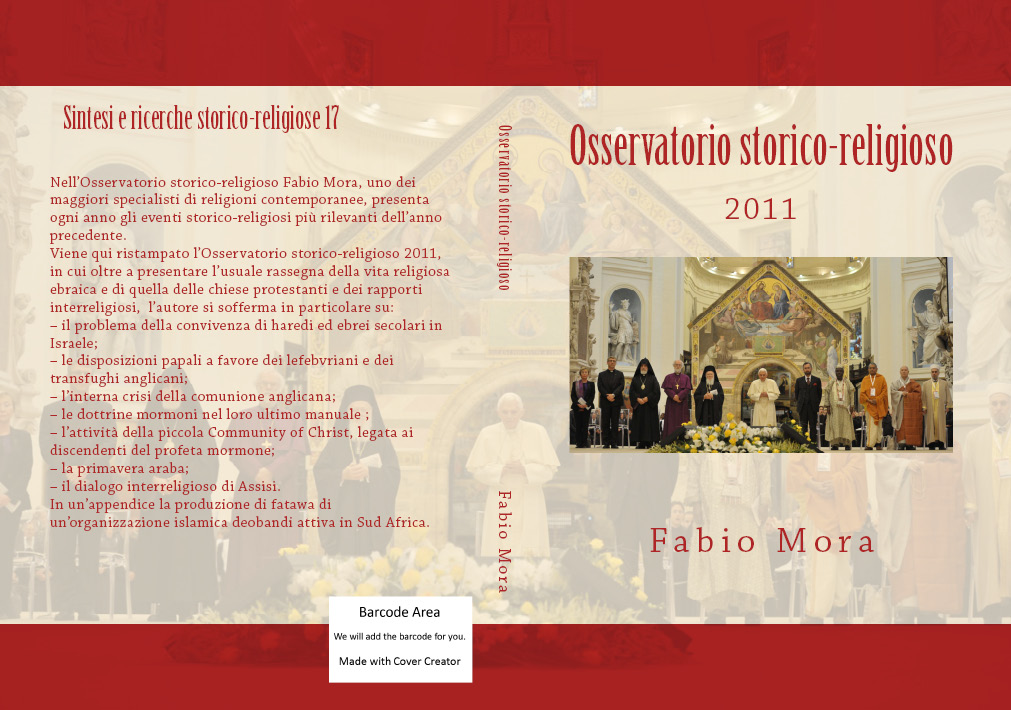
The most significant religious events of 2011 are presented.
For Judaism are analyzed:
- some important Orthodox decisions (on the determination of death, against homosexual marriage, defending circumcision from various attacks) and some efforts by liberal Orthodox to find not rabbinical, yet relevant roles for women in Judaism;
- several conflicts between Haredi and secular society in Israel, and among them a new case at Beit Shemesh, where a young girl terrified by Haredis became an international icon;
- several new standards and interpretations by the conservatives, on kashrut problems, on procedures to ascertain a doubtful Jewish identity, on deaf and dumbs;
- some problems in Israel and among them the polemics on quality of conversions.
For Christianity are analyzed:
- the attacks on the Coptic church, that continued even after the international shock of the New Year Alexandria bombing;
- the internal activity of the Russian Orthodox church and Bartholomew I of Constantinople’s ecumenical activity, along with some usual frictions between Moscow and Constantinople;
- two motu proprio by Benedict XVI (opening the year of faith, instituting a new Rota office for dissolving not consumed marriages and dealing with invalid ordinations – among them ordinations of women)
- the creation of two Catholic ordinariati (“bishoprics”) for Anglicans accepted in the Catholic church at the special conditions issued by Anglicanorum coetibus, and namely one for England and Wales, the other for the United States;
- a new document by the Congregation for the doctrine of faith on guidelines against sexual, pedophile abuses in the church, to which a large excursus is devoted;
- an instruction of Ecclesia Dei on the use of Latin liturgy granted by Summorum Pontificum, which authorizes its use also in the Holy Week without solving the problem of which prayer pro Judaeis must be used, every divergence (even Benedict XVI’s 2008 compromise formula) from the last vernacular form (1983) being very problematic for Jewish-Catholic relationships;
- some information on new saints and blessed, canonized in 2011, on other activities of the Roman curia, of the religious orders and the local churches;
- much information on the activities of Protestant churches: German Lutherans, American Lutherans, American Presbyterians, World communion of Reformed churches, Methodists, Baptists, Adventists, Mennonites and Amish, on the evolution of Anglican schism in North America and of the Anglican covenant;
- some information on ecumenical activities and bilateral theological dialogue.
For Mormons are examined their internal manuals of the main church (Utah), now normally published after many polemics on their secret status and some statistics data on their activity – alongside with a new divine revelation to the leader of the Community of Christ, a small church (1-2% of all Mormons) for more a century tied to the prophet’s family, now trying to revert back into Christian mainstream.
The Arab spring dominates the pages devoted to Islam – which are however complemented by an appendix analyzing in small detail a year of fatawa by a deobandi imam operating in South Africa.
Buddhism is always dominated by the Tibetan question, the activity of the Dalai Lama and his support for his heir apparent, the Karmapa Lama, who struggled with serious problems in India – but the foundation of a new international Buddhist umbrella organization was decided in August in New Delhi.
The section on interreligious dialogue is dominated by the new interreligious encounter of prayer at Assisi – an excursus, amply quoting original texts, rectifies the historically true spirit of Assisi 1986 against his arbitrary redefinition by Benedict XVI, who as card. Ratzinger had boycotted the epochal event and for its 25th anniversary had tried to falsify its real nature.
F. Mora, Osservatorio-storico religioso 2010, Charleston 2013, pp. 102, ISBN 9788890622236 (buy)
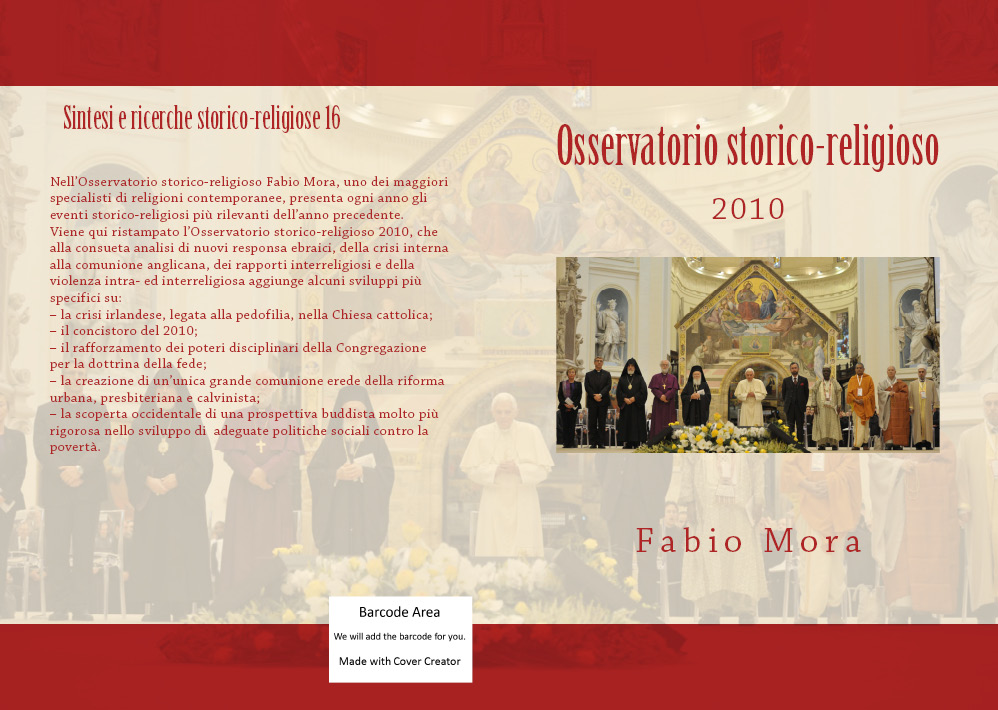
The most significant religious events of 2010 are presented. For Judaism are analyzed:
• several important Orthodox decisions (categorical rejection of the female rabbinate, adherence to a broader concept of kashrut food, verifying also ethical forms of food production);
• the controversy sparked by the Haredi refusal to integrate into the Israeli school system and national production;
• several authentic interpretations issued by conservative: on the use of the kippah required to non-Jews in the synagogue, on the authorization to bury non-Jewish relatives in a separate section of their cemeteries, on organ donation, but above all on reducing onomastic otherness of converts, especially in the case of children of a Jewish father and a not-Jewish mother or of adopted children;
• a conservative document on contraception, interesting because of its very dif-ferent logic, often antithetical both to Catholic and secular morality: it allows to care only of the efficiency of contraception after having fulfilled the moral obligation to procreate (with a recommendation to bring the minimum from two to three children, to counter the demographic weakness of Judaism), though still considering condoms as the less acceptable form of contraception because of their direct condemnation by the biblical and Talmudic precept, favoring hormonal contraception (pill), allowing the emergency contraception (morning after pill, taking effect before planting of the seed), but excluding from contraception abortifacient products, such as the famous pill RU-486.
For Israel, we examined the controversy ignited by too easy or difficult conversions, and the related issue of civil or inter-religious marriage, yet impossible in Israel.
The Christian section begins with the relatively minor activity of the Orthodox Churches. The Catholic section begins with the Benedict XVI and firstly his pastoral letter to the Catholics of Ireland, requiring a reflection on the Irish scandal in the broader context of the belated repression of pedophile clergy; of some importance is also his post-synodal exhortation Verbum domini. It follows an analysis of the substitution mechanisms in the consistory of 2010 of new cardinals replacing those too old to vote, mechanisms involving a subtle and articulated hierarchy of sees (elettorali, where a cardinal no longer elector is immediately replaced with a new cardinal elector; solo cardinalizie, whose presence in the constituency is reduced by the longevity and seniority at the appointment of the one cardinal, regularly assigned, but not always replaced at the earliest opportunity, occasionali, with a cardinal ad personam, allowing to temporarily involve many minor episcopal conferences). It is stressed a fact often forgotten by Vatican experts, the aging of the college of Cardinals due to the increasing age of the cardinals at their appointment, what could lead either to a parallel shortening of the experience of any cardinal-elector and an increasing age of the popes at their appointment (with a greater number of popes who will mainly reign after the eightieth birthday) or to a selection as papabili of the few younger cardinals, who might offer a long pontificate. Then are examined the new regulations, promulgated by the Congregation for the Doctrine of the Faith, of the most serious crimes, whose list was expanded to include both pedophile clergy and attempted ordination of a woman (thwarted by automatic excommunication latae sententiae of all participants). After the section dedicated to new canonizations and beatifications, another scandal dominates the section dedicated to the religious, that one that led to the extraordinary visitation of the Legionaries of Christ, who finally disavowed immorality and abuse of power of their idolized founder, Maciel Degollado, but leaves some doubt on previous tolerance of the order’s deviations and its failed dissolution. The Catholic section concludes with an analysis of the Synod of Bishops on the Middle East, the most important appointments (archbishops) and the creation of new dioceses.
In the next section devoted to Protestantism outstand the eleventh meeting of the World Lutheran Federation, but also resignations, at the first hint of scandal, of two women bishop of the German Lutheran church, and a difficult compromise in the Lutheran law on priests, which basically allows to tolerate their homosexual unions - the issue is very controversial in America, where a policy of weak opposition to homosexuality in the clergy is causing hemorrhage (approx. 4%) to the fourth subject Lutheran, the Lutheran Congregations in Mission for Christ (that do not call into discussions ordinations of women, rejected by the conservative Lutheran synod of Missouri). In the Calvinist and reformed world outstands the merger of the World Alliance of Reformed Churches with Reformed Ecumenical Council, forming a new World Communion of Reformed Churches which brings together all the churches of the urban or Calvinist reform (except for some very small but stubborn splinter groups) into an ecclesial subject demographically slightly higher than the Anglican and Lutheran (80 million vs. 75 and 70). Significant, however, is also the constitutional revision undergone by American Presbyterians. In the Anglican world continues the divarication of the three main currents (English, African and American Episcopal), polarized around the evaluation of homosexuality, but also the Catholic erosion of the English Anglican clergy, favored by Anglicanorum Coetibus, and by progresses in the introduction of a female episcopate. The chronicle continues by reporting more limited, but no less important decisions, taken from different branches of radical reform and non-conformism (Mennonites, Baptists) and the Seventh-day Adventist, and later on of ecumenical relations, and in particular the incorporation of Danish Lutherans into the Porvoo intercommunion, between Anglicans and Nordic-Baltic Lutherans. Outside the Christian galaxy there are several themes of great interest in 2010 for the Mormons.
In the absence of significant Islamic pronouncement, interesting are some opinion polls confirming the existence of an Islamic perspective antithetical to the Western one on many important points, such as polygamy, stoning adulterers, death penalty for apostates and assessment of terrorism.
It follows a broader discourse on Buddhism, from which, partly with solid conviction, partly as a contingent and cunning reaction to the international economic crisis, the West has just copied the statistical study of Gross National Happiness, controversially introduced in the 70s in Bhutan as an alternative to gross national product, but also consistently applied, in terms unthinkable in the West, as a binding criterion of any legislation. So it was avoided the typical evolution of every decolonized country, a growth of the gross national product at the expense of the well-being subjectively per-ceived by the population. The last section, on interreligious relations, must record a significant increase in negative behaviors, both in terms of violence and of serious discrimination.
F. Mora, Osservatori-storico religiosi 2008 e 2009, Charleston 2013, pp. 188, ISBN 978-1494988739 (buy)
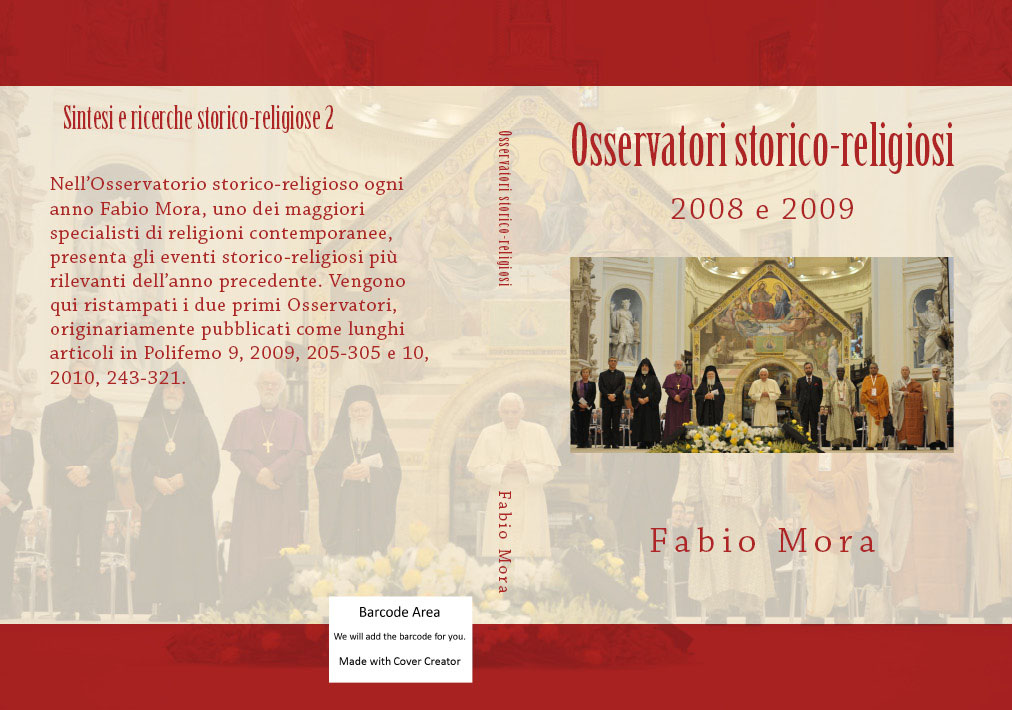
In Osservatorio storico-religioso every year are presented the most important religious-historical events of the previous year. Here are reprinted the first two installments, that were first published as papers in Polifemo.
Osservatorio 2008 presents a chronicle of religious events in 2008.
For Hebraism the new, stricter religious politics of Israel’s chief rabbi is analysed, which makes problems even to American Orthodox Jewry. Its alignment on John Paul II’s ethical intransigency is still working in a common plea of Rabbinical Council (Orthodox Jewry) and American Catholic bishops for a heterosexual definition of marriage. Then it is briefly reported on recent positions of the Rabbinical Assembly (Conservative Judaism) and some responsa from the Committee on Jewish Law and Standards : among them one on prenatal screening and another on the moral obligations of any Jewish employer. For the Central Conference of American Rabbis (Reform Judaism) it is reported its adhesion to Hekhsher Tzedek, a program promoted (after a great scandal) by the Conservatives to assure a correct treatment of animals by firms producing kosher food. It is further reported on religious tensions in Israel on several items: admissions of women to rabbinate, secularism and Haredi modesty police – the greatest event was however the fiasco of the parliamentary marathon to make a new, stricter law to prohibit any commerce of leavened products in Easter times after a liberal interpretation of the former law.
In the Christian section it is reported on nominations in the Orthodoxy (new Patriarch of Russia, new archbishops of Athens and Serbia) and on a summit of Orthodox patriarchs. The Catholic section begins with Pope Benedict’s activity: travels to United States, Australia and France, catechesis on Paul and the fiasco of the speech he could not hold on academical year’s inauguration of Rome’s University. It follows an analysis of Vatican activity and namely two new texts (Biblical Pontifical Commission, Bible and Moral; Theological commission, The Search for Universal Ethics), the new blessed of 2008, other Vatican documents and the main event, the bishops’ Synod.
In the Protestant section it is reported on the yearly meeting of EKD (German Lutherans) and its document on climate change and on some Denkschriften and Texte of EKD on various themes; on preparations for the merger of the two main international organizations of Reformed Churches in a new World Communion of Reformed Churches, a document of the Swiss Reformed Church on a Swiss referendum against minarets, preparations of a constitution for the Hungarian Reformed Church, in Hungary and abroad, on the theological activity of the Church of Scotland and of the Presbyterian Church in the USA; on the Pananglican conference of Lambeth and on the African schism, which opposes the liberal evolution of American Episcopals (with four dioceses in the USA adhering to a new conservative Anglican communion); on American Baptists and Methodists and American theological/political issues on marriage and homosexuality. In the ecumenical section it is reported on the Catholic-Orthodox document of Ravenna.
It is also reported on the choice of the new president of Mormons, the short political experience of their candidate for USA presidency and a new scandal of polygamist “Mormon” fundamentalists. In the Islamic section is mainly offered a wide analysis of the document A common word between us and you and Christian reactions to it, in the broader context of the Amman process, fatawa production and opposition between Universal and Islamic declarations of human rights. In the Buddhist section it is reported on Dalai Lama’s ban on Dorje Shugden and its followers, on the Chinese political ban on not recognized lamas, that could enhance chances of an interim of Kampala Lama during the education of the next Dalai Lama, who will probably be searched in the exile. In the interreligious section the main theme is the controversial film Fitna, which caused a crisis not smaller than the Danish cartoons’ one, but it is also reported on polemics on The Berlin Declaration of the uniqueness of Christ and Jewish Evangelism today.
Osservatorio 2009 presents a chronicle of religious events in 2009.
For Hebraism are analysed the very different documents through which orthodox and conservatives react to the deep Hebraic involvement in the world financial crisis; conflicts in Hebraism and especially in Israel about the quality of conversions, struggles on the election of Jerusalem’s chief rabbis, Israeli discussions on Shabbat and divorce, but also on prohibition of leavened products during the Easter period; the religious redefinition of Hebrew schools imposed by Britain’s Supreme Court.
In the Christian section it is reported on nominations in the Orthodoxy (new Patriarchs of Russia and Serbia) and on an antiecumenical Orthodox document. The Catholic section begins with Pope Benedict’s apostolic travels, especially into the Holy Land, his motu proprio Omnium in mentem. It is further analysed Vatican activity and namely motu proprio Ecclesiae unitatem (which strictly subordinates the commission Ecclesia Dei to the Congregation for the doctrine of the faith); with refer on the new blesseds of 2009, on the dialogue between the Catholic Church and the Oriental-Orthodox ones, on religious orders, on the bishops’ Synod on Africa (October 2009) and on preparations for the Synod on Middle-East.
In the Protestant section it is reported on the 11th synod of EKD (German Lutherans) and on some of its documents; on Reformed celebrations of the 5th Centenary of Calvin’s birth and on some documents of the Swiss church; on the complex realignment in the Anglican church, with the begin of a schism in the Episcopal church, the Catholic interference of Anglicanorum coetibus (which for the moment made it possible to intercept groups which had arisen in previous schisms) and new conflicts for the new election of an homosexual bishop in the Episcopal church. On the Mennonite conference, on Amish and Hutterites, on the annual conference of Southern Baptists, on the quadrennial conference of Methodists (which has confirmed moral standards against homosexuality) and the failure of a deep constitutional reform which would have deprived the American congregations of their centrality in the Methodist Church; on the yearly London meeting of Quakers, who has fully accepted homosexuality. In the ecumenical section it is reported on a Protestant polemic against the Orthodox Church on the human rights.
It is also reported on the return of polemics on polygamy amongst fundamentalist Mormons, while they are very engaged on the defence of the heterosexual, monogamist family.
In the Islamic section is mainly offered a concrete analysis of the increasing adoption of sharia. In the Buddhist section follows an analysis of preparatives for Dalai Lama’s succession, which will involve a critical period for Tibetan Buddhism. In the interreligious section it is reported on the increasing Islamic intolerance, on polemics on Islamic veil and its prohibition, on an interesting analysis of interreligious attitudes of Israeli Hebrews; we end commenting a document of Orthodox Hebrews, which is deeply critic of another document of USA Catholic bishops, and observing how Benedict’s church is losing a credit acquired among Jews by John Paul II.